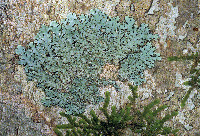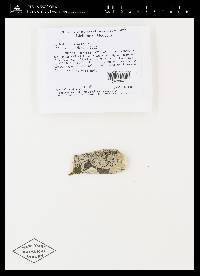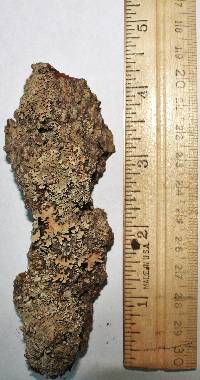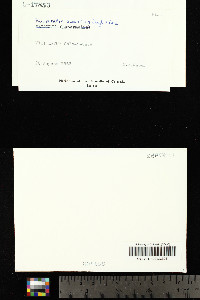
- Home
- Search
- Images
- Species Checklists
- US States: O-Z >
- US National Parks
- Central America
- South America
- US National Parks
- Southern Subpolar Region
|
|
|
|
Family: Parmeliaceae
[Parmelia marginalis Lynge, moreParmelia marginalis var. marginalis Lynge, Parmelia njalensis C.W. Dodge, Parmelia scortella Nyl.] |
Mycobank No.: MB 341610 Basionym: Parmelia scortella Nyl., Flora 68: 615. 1885. Lectotype: North America, United States: Texas, leg. C. Wright, 1850 (FH-Tuck!, isotype in H-Nyl!). Thallus corticolous, greenish gray becoming pale dusky, greenish or olivaceous gray in the herbarium; medulla white. Lobes ca. 0.3–1.2 (–1.5) mm wide, dichotomously, trichotomously or irregularly branched, contiguous to ± imbricate or rarely crowded, adnate, firmly attached; apices truncate to subtruncate; margin smooth and sinuous to subcrenate or subirregular. Upper surface continuous with occasional irregular fissures, smooth, lacking laminal ciliary bulbs; maculae weak, punctiform, laminal, ±frequent, amidst scars left by fallen isidia; adventive lacinules rare to frequent, short, randomly distributed along the margins or rarely amidst the isidia. Cilia black to brown, simple to eventually furcate and then subdichotomously branched, abundant, but confined to the lobe margins, with basal bulbs. Soredia and pustules absent. Isidia scarce to frequent, laminal, simple to sparsely branched, eciliate. Lower surface ±shiny, smooth to subrugose, pale brown throughout, not conspicuously darkened towards the center; densely rhizinate in the center, sparsely rhizinate to papillate along the margin. Rhizines pale to dark brown, simple, soon becoming furcate and then dichotomously or irregularly branched, abundant and evenly distributed (almost like a tomentum), some rhizines with inconspicuous basal bulbs. Apothecia rare (not observed in Galapagos specimens), if present laminal or submarginal, subconcave to plane, adnate to sessile; margins smooth to partially subcrenate and occasionally isidiate, ecoronate; discs pale brown, epruinose, imperforate; ascospores subglobose to ellipsoid or oval, sometimes with weakly acuminate apices, (5.5–) 7.0–11.0 (–12.5) × 4.0–5.0 (–6.0) µm, epispore 0.5–1.0 µm thick (Benatti & Elix 2012). Pycnidia (not examined in Galapagos specimens), submarginal, with black ostioles; conidia bacilliform to weakly bifusiform, some appearing weakly sublageniform, (4.0–) 5.0–7.0 × ca. 0.75 µm (Benatti & Elix 2012). Spot test reactions. Cortex K+ yellow, C−, KC−, P+ yellow, UV− (dull); medulla K−, C+ pale pink (rosé), KC+ pale pink (rosé), P−, UV− (dull). Chemistry. Cortex with atranorin, medulla with gyrophoric acid. Distribution and ecology. Cosmopolitan; reported from Asia (Japan), Africa (Sierra Leone), North- (USA), and South America (Venezuela, Brazil) (see Benatti & Elix 2012); new to Galapagos and Ecuador; the only specimen currently known from Galapagos was found in the agricultural areas of the humid zone of Santa Cruz Island, on a trunk of the introduced Guava tree (Psidium guajava). Specimens examined. Ecuador. Galapagos Islands: Isla Santa Cruz Island, gardens at western outskirts of Bellavista, 0˚ 41’ 33.00” S, 90˚ 19’ 38.00” W, 215 m alt., agricultural area, on Psidium guajava, 20-Mar-2006, Aptroot, A. 65313 (CDS 31899). from: Nash, T.H., Ryan, B.D., Gries, C., Bungartz, F., (eds.) 2002. Lichen Flora of the Greater Sonoran Desert Region. Vol 1. Thallus: adnate, foliose, 2-8 cm in diam., fragile, irregularly lobate lobes: sublinear, moderately imbricate, elongate, plane to subconvex, separate, 0.5-1.5 mm wide; apices: subrotund, sometimes dissected, ciliate; cilia: dense, bulbate, sometimes branched isidia: laminal, dense, cylindrical, simple to coralloid, sometimes darkened apically; soredia and pustulae absent upper cortex: pale gray, smooth to rugose, shiny, faintly or distinctly white maculate medulla: white, with continuous algal layer lower cortex: black centrally, pale marginally, densely rhizinate; rhizines, branched, black to medium brown Apothecia: rare, laminal, 1-2 mm wide, sessile to subpedicellate; disc: red-brown to dark brown; margin: outer rim usually isidiate, inner rim ecoronate, ascospores: ellipsoid, 8-10 x 4-6 µm Pycnidia: not seen Spot tests: upper cortex K+ yellow, C-, KC-, P+ yellow; medulla K-, C+ red, KC+ red, P- Secondary metabolites: upper cortex with atranorin and chloroatranorin; medulla with gyrophoric acid (major). Substrate and ecology: on small trees in open habitats World distribution: pantropical and extending into subtropics Sonoran distribution: oak forests at intermediate elevations in Sonora. |
|
|
|

![Bulbothrix scortella (Nyl.) Hale [Aptroot, A. 65313 (CDS 31899)] Bulbothrix scortella image](/imglib/lichens/CDS_Lichens/00031/CDS_31899_MX_1538_print_1556295297.jpg)

![Bulbothrix scortella (Nyl.) Hale [Aptroot, A. 65313 (CDS 31899)] Bulbothrix scortella image](/imglib/lichens/CDS_Lichens/00031/CDS_31899_MX_1535_print_1556295321_tn.jpg)























